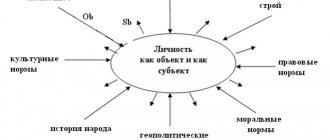Raymond Bernard Cattell is a British and American psychologist, author of the 16-factor personality model.
Born March 20, 1905 in Staffordshire, England. The middle son in the family, not receiving the attention of his father, but under the care of his mother, was in relative freedom. I spent time exploring the coast on my own boat or simply wandering along the seashore.
The advent of the First World War left a strong imprint on his mind. “ Constantly and silently, an unchanging sense of seriousness entered my life, based on the feeling that it was hardly permissible to be less selfless than these wounded soldiers, and a new feeling for a boy - the transience of human life and the need to improve it as much as possible
“,” Cattell later recalled.
Activity
Until 1932 he lectured at University College Exeter. He moved to Leicester, taking up the post of director of the children's clinic at the city psychiatric hospital. During his five years of work, he was also able to devote time to research regarding the measurement of human intelligence. At the same time, he published several articles and even a book.
Having begun the search for a place suitable for conducting psychological research, in 1937 he became an assistant at Columbia Normal University, accepting the offer of E.L. Thorndike. In 1938 he moved to Worcester, Massachusetts, where he became the Stanley Hall Chair at Clark University. In 1941 he moved to teach at Harvard University. Her theory was greatly influenced by the debates conducted with G. Allport. During World War II, he participated in work on personality tests used in the selection of officers. During this work, he had the opportunity to realize all the advantages of working in a team. After the war, he became director of the Laboratory of Personality and Group Analysis at the University of Illinois, where he was also awarded the title of "Outstanding Professor and Scientist."
In 1949, he became one of the founders of an organization that promotes in scientific and medical circles the tests and methods developed by the Laboratory of Personality and Group Analysis - the Institute of Personality and Abilities Testing (IPAT).
In 1973 he moved to Boulder, founding the Institute for the Study of Moral and Self-Realization. Since 1977, he became a consulting professor at the University of Hawaii, as well as an emeritus professor at Illinois. He died of natural causes, having lived to the age of 92, on February 2, 1998, at his home in Hawaii.
Content
- 1 Description of the technique
- 2 Theoretical foundations
- 3 Procedure 3.1 Instructions
- 4.1 Key to the Cattell Technique (Forms A and B)
- 5.1 Description of primary factors
- 6.1 Text of the questionnaire (Form A)
- 7.1 Children's version of the Cattell questionnaire
Works
Trait theory
A unique personality theory that allows you to analyze behavior using statistical analysis. This theory describes personality traits identified through factor analysis.
The analysis was based on data obtained from three sources:
- a person’s behavior in certain life situations, as well as assessment by people who know him well;
- human behavior in a specially simulated test situation;
- a person’s self-esteem based on the questionnaires he filled out.
A personality trait is a relatively constant tendency to react to certain situations in a certain way. Personality allows us to predict a person’s behavior in a given situation. According to Cattell, the main differences between people are formed by different combinations of basic traits.
The author divided all traits into two types:
- Initial - responsible for typical forms of behavior and are fixed in the deep layers of the personality, they are distinguished by constancy and patterns in manifestation.
- Superficial – controlled by the original ones, observed in conjunction with each other. Thus, indecision, vanity, worry and anxiety are a combination that is a superficial feature of neuroticism.
The 16 initial traits identified by the author later became the basis for the “Sixteen Personality Factors” questionnaire.
Cattell test for 12-18 years old
A test adapted for schoolchildren, which allows you to diagnose 14 different personality factors within 30-40 minutes.
Books
During his life, Cattell wrote 55 books and more than 500 articles. Here is a list of the most significant works in the direction of systematic research of human personality:
- "Description and Measurement of Personality" (1946);
- “Personality: a systematic theoretical and factual study” (1950);
- "Personality and Motivational Structural Dimension" (1957);
- "Scientific Analysis of Personality" (1965);
- “Inheritance of Personality and Abilities” (1982);
- "Beyondism: Religion from Science" (1987).
Hans Eysenck's theory of personality types
The essence of Eysenck's theory is that personality elements can be arranged hierarchically. In his schema there are certain supertraits, or types, such as extraversion, that have a powerful influence on behavior. In turn, he sees each of these supertraits as built from several component traits. These composite traits are either more superficial reflections of the underlying type or specific qualities inherent in that type. Finally, traits consist of numerous habitual responses, which in turn are formed from specific responses. Consider, for example, a person who is observed to exhibit a specific response: smiling and extending his hand when meeting another person. If we see him doing this every time he meets someone, we can assume that this behavior is his habitual response to greeting another person. This habitual response may be associated with other habitual responses, such as a tendency to talk to other people, going to parties, etc. This group of habitual responses forms the trait of sociability, which usually exists in conjunction with a predisposition to respond in an active, lively and confident manner . Collectively, these traits make up a supertrait, or type, which Eysenck calls extraversion.
Considering the hierarchical model of personality according to Eysenck, it should be noted that here the word “type” assumes a normal distribution of parameter values on the continuum. Therefore, for example, the concept of extraversion represents a range with upper and lower limits within which people are located in accordance with the severity of this quality. Thus, extraversion is not a discrete quantitative indicator, but a continuum. Therefore, Eysenck uses the term “type” in this case.
Eysenck used a variety of methods to collect data about people: self-observation, expert assessments, analysis of biographical information, physical and physiological parameters, as well as objective psychological tests. The obtained data were subjected to factor analysis to determine the personality structure. In his early research, Eysenck identified two main types, which he called introversion-extraversion and neuroticism-stability. These two dimensions of personality are orthogonal, i.e. they are statistically independent of each other. Accordingly, people can be divided into four groups, each of which represents some combination of a high or low score in the range of one type, together with a high or low score in the other type range. Thus, each type is associated with characteristics whose names resemble descriptions of personality traits.
In considering the nature of these four groups, two points must be kept in mind. First, both type ranges are normally distributed, continuous, and thus allow for a wide range of individual differences. Second, the descriptions of the traits associated with each type represent extreme cases. Most people tend to be closer to the middle point - in both ranges of types and therefore end up with less extreme characteristics.
Each category, including its constituent traits, results from a combination of high and low levels of introversion and extraversion with high or low levels of stability and neuroticism.
People who are both introverted and stable tend to adhere to norms and rules, and to be caring and considerate. Conversely, the combination of introversion and neuroticism suggests an individual's tendency to exhibit more anxious, pessimistic, and withdrawn behavior. The combination of extraversion and stability brings to behavior such qualities as caring, generous and sociable. Finally, people with extraversion and high neuroticism are likely to be aggressive, impulsive, and excitable. It should be noted that Eysenck attached particular importance to individual differences. Thus, no combination of these personality types can be preferred. The carefree and sociable type of behavior has both good and negative aspects; the same can be said about a quiet, reserved demeanor. They're just different.
Not long ago, Eysenck described and introduced into his theory a third type of personality dimension, which he called psychoticism - the strength of the superego. People with a high degree of expression of this supertrait are self-centered, impulsive, indifferent to others, and tend to resist social principles. They are often restless, have difficulty communicating with people and do not receive their understanding, and deliberately cause trouble to others. Eysenck proposed that psychoticism is a genetic predisposition to become a psychotic or psychopathic personality. He views psychoticism as a personality continuum on which all people can be placed and which is more pronounced in men than in women.
Heritage
«Personality is what predicts what a person will do in a given situation. The purpose of psychological research of personality is to establish the laws by which people behave in all types of social situations and general environmental situations
"Cettel wrote.
Cattell has received two awards, the Darwin Society and the Wenner Gren, and also received the Outstanding Measurement Award from the American Psychological Association. Was a full member of the British Psychological Society
His work at the Institute of Personality and Aptitude Testing (IPAT) was continued by his daughter, Heather Cattell.
Processing the results
The received data is processed using a key.
The coincidence of the subject’s answers with the “key” is assessed as two points for answers “a” and “c”, the coincidence of the answer “b” is scored as one point. The sum of points for each selected group of questions results in the value of the factor. The exception is factor “B” - here any match of the answer with the “key” gives 1 point.
Key to the Cattell Technique (Forms A and B)
Key to the Cattell Technique (Form C)
Key to the Cattell Method (Form 13PF)
The resulting value of each factor is converted into walls (standard units) using the tables provided.
Tables for converting raw points into walls (forms A and B)
Table for converting raw points into walls (Form C)
Raw Points Interpretation Table (Form 13PF)
The walls are distributed on a bipolar scale with extreme values of 1 and 10 points. Accordingly, the first half of the scale (from 1 to 5.5) is assigned the “—” sign, and the second half (from 5.5 to 10) the “+” sign. From the available indicators for all 16 factors, a so-called “personality profile” is constructed.
In addition to the original 16 factors, four second-order factors can be identified.
Formulas for calculating four secondary factors:
Secondary factors are calculated only for walls.
1. Anxiety (F1).
2. Introversion - extraversion (F2).
3. Sensitivity (F3).
4. Conformity (F4).
An example of constructing a “personality profile”
Interpretation of results
Description of primary factors
Description of secondary factors
When interpreting, attention is paid primarily to the “peaks” of the profile, i.e., the lowest and highest values of factors in the profile, especially those indicators that in the “negative” pole are within the boundaries of 1 to 3 walls, and in the “positive” pole » - from 8 to 10 walls.
Interpretation of combinations of primary factors
When interpreting the results obtained, it is advisable to use not only the severity of individual factors, but also their combinations that form symptom complexes of communicative, intellectual, emotional and regulatory personal properties. In this case, it is necessary to take into account not only the pole values of the factors, but also the average ones, which are quite often found in the practice of psychologists.
The group of communicative properties is formed by the following factors:
- A – sociability
- N – courage
- E – dominance
- L – suspicious
- N – diplomacy
- Q2 – independence.
The group of intellectual properties includes the following factors:
- B – intelligence
- M – dreaminess
- N – diplomacy
- Q1 – receptivity to new things.
The group of emotional properties combines the following factors:
- C – emotional stability
- F – carelessness
- H – courage in social contacts
- I – emotional sensitivity
- O – anxiety
- Q4 – tension
The group of regulatory personality properties includes the following factors:
- Q3 – self-discipline
- G – moral normativity
Literature
- Kapustina A. N. Multifactorial personal technique of R. Cattell. - St. Petersburg: Rech, 2001.
- Practical psychodiagnostics. Methods and tests. Tutorial. - Samara: Publishing House "Bakhrakh", 1998.
- Rogov E.I. Handbook of a practical psychologist in education: Textbook. – M.: VLADOS, 1996.
- Batarshev A.V. Diagnosis of borderline mental disorders of personality and behavior. - M.: Publishing House of the Institute of Psychotherapy, 2004. - 320 p.
- Vyboishchik I.V., Shakurova Z.A. Personality multifactor questionnaire by R. Cattell. Chelyabinsk, SUSU Publishing House, 2000. - 54 p.








